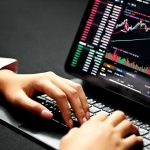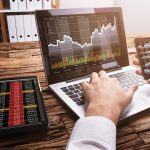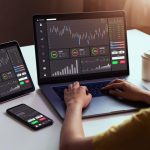Proprietary trading, commonly known as prop trading, is a form of trading where financial institutions or individual traders trade using their own capital rather than executing trades on behalf of. It involves speculating on financial instruments, such stocks, bonds, commodities, derivatives, in order to generate profits for the trading firm.
In prop trading traders utilize their expertise, market knowledge, and analysis to identify opportunities and execute trades that aim to generate returns. Unlike traditional trading, where brokers earn commissions or fees for executing client orders, prop traders directly benefit from their successful trades by reaping the profits or sharing them with the trading firm they are affiliated with.
Prop trading has gained prominence in recent years due to the increasing sophistication of financial markets and advancements in technology. It attracts both individual traders seeking higher returns and financial institutions looking to maximize their profitability.
In this article, we will explore the profitability of prop trading in detail. We will examine the factors that contribute to the profitability of prop trading, the potential risks involved, and various strategies employed by prop traders to achieve success. By gaining a deeper understanding of the dynamics of prop trading, readers will be able to assess its potential as an investment avenue or career path.
What Is Proprietary Trading ?
Proprietary trading, often referred to as prop trading, is the practice of trading financial instruments using a firm’s own capital. Unlike traditional trading where brokers execute trades on behalf of clients, prop trading involves trading with the firm’s money to generate profits for the trading entity itself.
In prop trading, traders make buy and sell decisions based on their analysis, market expertise, and trading strategies to capitalize on short-term price fluctuations or exploit market inefficiencies. The key distinction between prop trading and other forms of trading lies in the source of funds used for executing trades. In prop trading, it is the firm’s capital that is being put at risk, allowing the trading entity to directly benefit from successful trades.
One of the primary motivations for engaging in prop trading is to generate substantial profits. Since prop traders are using their own capital, they have the potential to earn significant returns if their trading strategies prove successful. This incentive to generate profits drives prop traders to constantly analyze market trends, develop trading strategies, and adapt to changing market conditions.
In contrast to prop trading, other forms of trading typically involve executing trades on behalf of clients. In these cases, brokers or investment advisors act as intermediaries, executing trades based on client instructions and earning commissions or fees for their services. The profitability of these trades is directly tied to the performance of the client’s investments, rather than being directly tied to the trading entity itself.
Furthermore, prop trading often involves a higher degree of risk compared to other forms of trading. While traders can potentially achieve high returns, they also face the possibility of losses. The use of leverage, complex financial instruments, and the volatile nature of financial markets contribute to the inherent risk in prop trading.
In summary, proprietary trading is the practice of trading financial instruments using a firm’s own capital, aiming to generate profits for the trading entity. It differs from other forms of trading by utilizing firm capital, allowing traders to directly benefit from successful trades and assuming greater risks.
Factors Affecting Profitability in Prop Trading
Profitability in prop trading is influenced several key factors that determine trader’s success. These factors a trader’s skills, experience, trading strategy, and the effective implementation of risk management practices.
-
Skills and Expertise: A trader’s skills and expertise a vital role in prop trading profitability. Knowledge of financial markets, understanding of various trading instruments, technical analysis, fundamental analysis, and the ability to interpret market trends are all crucial skills for successful prop traders. Constantly honing these skills through education and practical experience is essential.
-
Experience: Practical experience in prop trading is invaluable for refining skills, developing market intuition, and gaining a deep understanding of trading patterns. Experienced traders often possess a stronger ability to identify profitable opportunities, make quick and informed decisions, and navigate market volatility.
-
Trading Strategy: A well-defined and consistently applied trading strategy is vital for profitability in prop trading. Traders need to identify their preferred trading style, such as scalping, day trading, swing trading, or trend following, and develop a strategy aligned with their strengths and risk appetite. A robust trading strategy incorporates entry and exit rules, risk management principles, and a disciplined approach to decision-making.
-
Risk Management: Effective risk management is crucial to maintaining profitability in prop trading. Traders must set limits on position sizes, employ stop-loss orders to minimize losses, and diversify their portfolios to spread risk. Implementing risk management techniques like setting risk-reward ratios, using proper leverage, and understanding the potential impact of adverse market conditions can help protect capital and preserve profitability over the long term.
-
Technology and Tools: Utilizing advanced trading platforms, real-time market data, and trading tools can significantly enhance a trader’s profitability in prop trading. Automation, algorithmic trading, and access to high-quality research and analysis can provide traders with a competitive edge, enabling them to execute trades efficiently and capitalize on market opportunities.
- Psychological Factors: Emotional control, discipline, and a strong mindset are crucial for success in prop trading. Traders need to manage fear, greed, and impulsive decision-making to avoid emotional trading biases. Building resilience, maintaining focus, and sticking to the trading plan, even during periods of losses or challenging market conditions, can contribute to long-term profitibality
By effectively combining these factors, prop traders can improve their chances of achieving profitability. However, it’s important to note that profitability in prop trading is not guaranteed, and market conditions can impact trading performance. Continuous learning, adaptation, and staying updated with market trends are key to maintaining profitability in this dynamic field.
Trading Strategies in Proprietary Trading
Proprietary trading encompasses a wide range of trading strategies that prop traders employ to generate profits. Here, we will explore some of the common trading strategies utilized in prop trading.
- Day Trading: Day trading involves executing multiple trades within a single day, with the aim of capturing short-term price fluctuations. Day traders typically close all their positions by the end of the trading day, minimizing exposure to overnight market risks. They rely on technical analysis, charts, patterns, and indicators to identify short-term trading opportunities.
- Swing Trading: Swing trading focuses on capturing medium-term price movements within the broader trends of the market. Swing traders aim to hold positions for several days to weeks, taking advantage of price swings generated by market events, news releases, or technical patterns. They often combine technical analysis with fundamental analysis to identify potential entry and exit points.
- Trend Following: Trend following is a strategy that aims to profit from identifying and following established market trends. Traders using this strategy anticipate that an established trend in a particular direction will continue and take positions in alignment with that trend. This strategy involves monitoring moving averages, trendlines, and other technical indicators to identify and ride trends to maximize profits.
- Arbitrage: Arbitrage is a strategy where traders exploit price inefficiencies between different markets or instruments. Prop traders identify price discrepancies and take advantage of them by simultaneously buying and selling related securities or derivatives to lock in risk-free profits. This strategy typically requires advanced technology, low-latency trading, and sophisticated market analysis tools.
- Algorithmic Trading: Algorithmic trading, also known as algo trading, involves using computer algorithms to execute trades based on predefined rules and parameters. Prop traders design algorithms that automatically analyze market data, identify trading signals, and execute trades with minimal human intervention. Algorithmic trading enables traders to take advantage of high-speed market opportunities and execute trades with precision and efficiency.
- Quantitative Trading: Quantitative trading relies on complex mathematical models, statistical analysis, and historical data to identify trading opportunities. Prop traders develop and fine-tune quantitative models that generate trading signals. These models often incorporate machine learning techniques and advanced statistical analysis to make informed trading decisions.
It’s crucial to note that the choice of trading strategy depends on a trader’s risk appetite, time commitment, and skill level. Successful prop traders often combine multiple strategies or tailor them to suit their specific trading style and market conditions. Constant evaluation, adaptation, and backtesting are crucial in refining and optimizing trading strategies.
Market Conditions and Profitability
Market conditions have a significant impact on the profitability of prop trading, with factors such as volatility and liquidity playing crucial roles. Let’s explore how these conditions influence prop trading profitability:
- Volatility: Volatility refers to the magnitude and frequency of price fluctuations in the market. High market volatility creates more trading opportunities for prop traders, as price movements provide potential profit opportunities. Traders who thrive on short-term price fluctuations, such as day traders, may find increased profitability during volatile market conditions. However, increased volatility also comes with higher risks, as price swings can be unpredictable and result in larger losses if not managed carefully.
- Liquidity: Liquidity represents the ease of buying and selling assets in the market. Higher liquidity enhances a trader’s ability to enter and exit positions at desired prices. In liquid markets, prop traders can execute trades quickly with minimal impact on prices, allowing them to secure favorable entry and exit points. This improves the efficiency of trading strategies and enhances profitability. On the other hand, lower liquidity can make it challenging to execute trades at desired prices, increase slippage, and potentially reduce profitability.
- Market Trends: Prop traders are heavily influenced by market trends. During trending markets, where prices consistently move in one direction, traders using trend-following strategies can achieve higher profitability. However, in sideways or range-bound markets, where prices move within a certain range, trend-following strategies may result in reduced profitability as price movements lack clear direction. Traders need to adapt their strategies and utilize different approaches based on the prevailing market trends.
- News and Events: News releases, economic data, geopolitical events, and market announcements can significantly impact market conditions and trading profitability. Prop traders often react to news events by adjusting their positions or taking advantage of market inefficiencies created by sudden shifts in sentiment or new information. It’s important for traders to stay informed and adapt their strategies to effectively respond to market-moving events.
- Correlation and Diversification: Market conditions can also influence the degree of correlation between different assets. During periods of high correlation, where multiple assets move in sync, diversification may be less effective in reducing portfolio risk. This can affect profit potential as a prop trading strategy that relies on diversification to spread risk may yield smaller returns. Conversely, during periods of low correlation, diversification can be more effective in mitigating risk and enhancing profitability.
Overall, prop traders need to closely monitor market conditions, adapt their strategies accordingly, and employ risk management measures to enhance profitability. Profiting from market conditions requires a combination of skill, experience, analysis, and proactive decision-making.
Costs and Fees
Prop trading involves various costs and fees that traders need to consider. Let’s explore some of the common expenses associated with prop trading:
- Trading Capital: Prop traders are required to have sufficient trading capital to participate in the markets. This capital can be self-funded or provided by the proprietary trading firm. The amount of trading capital can vary depending on the firm’s requirements and the trader’s experience and track record.
- Trading Commissions: Prop traders often incur trading commissions that are paid to the brokerage or exchange for executing trades. These commissions can be based on a per-share or per-trade basis and vary depending on the asset class and trading volume. It’s important for traders to factor in these costs when determining their profitability.
- Market Data Fees: Access to real-time market data is essential for prop traders to make informed trading decisions. However, market data providers often charge fees for accessing this data, which can vary depending on the level of data and the exchanges being accessed. Traders need to consider these fees when selecting data providers and maintaining the necessary market information for their trading strategies.
- Technology and Infrastructure: Prop traders rely on advanced trading platforms, high-speed internet connections, and robust infrastructure to execute trades efficiently. These technological requirements come with associated costs, such as leasing trading software, maintaining hardware, and paying for co-location services. Traders must consider these expenses when setting up their trading infrastructure.
- Risk Management and Analytics Tools: Effective risk management and data analytics are crucial for prop traders. The cost of acquiring and utilizing risk management software, analytical tools, and trading simulators needs to be taken into account. These tools help traders monitor their positions, assess market risk, and refine their trading strategies.
- Training and Education: Continuous learning and skill development are vital for prop traders. Traders may invest in training courses, educational materials, or mentorship programs to enhance their knowledge and improve their trading performance. The cost of these education and training resources should be considered as part of a trader’s overall expenses.
It’s essential to carefully evaluate these costs and fees to properly assess the profitability of prop trading endeavors. Traders should factor in these expenses when developing trading strategies and determining risk-to-reward ratios. It’s also recommended to review and compare costs from different brokers, data providers, and service vendors to optimize trading-related expenses.
If there are any specific details or additional aspects related to costs and fees in prop trading that you would like me to include, please let me know.
Propiy.com: Revolutionizing Trading
In the dynamic world of financial trading, Propiy.com emerges as a game-changer, offering traders a unique platform where expertise meets opportunity. Propiy.com stands out in the realm of prop trading, providing traders with the essential capital and tools needed to navigate and succeed in the ever-evolving financial markets.
Expert Capital Provision for Every Trader
At Propiy.com, we understand that access to sufficient capital can be the biggest hurdle for many traders. That’s why we’ve dedicated ourselves to removing this barrier. Whether you’re a seasoned trader or just starting, our platform provides the financial backing you need to fully leverage market opportunities.
Partnering with Industry Leaders
Our collaboration with top-tier brokers like Propridge ensures that our traders have access to a broad range of markets and assets. This partnership combines Propridge’s brokerage expertise with our innovative approach to capital management, creating a synergy that benefits our traders significantly.
Education and Community
We believe in nurturing a community of informed traders. Propiy.com hosts a wealth of educational resources and forums where both new and experienced traders can learn, share, and grow together.
Safe, Transparent, and Reliable
Security and transparency are at the heart of everything we do at Propiy.com. Traders can rest assured that they are operating in a safe and trustworthy environment, with all the support they need to trade confidently.
Join us at Propiy.com, where your trading ambitions are fueled with the right capital, tools, and community support. Experience a platform that’s more than just a prop trading site; it’s a pathway to your trading success.”

 Check propiy.com youtube
Check propiy.com youtube 



The use of offensive and immoral words and content in any form and by any person is prohibited.
Publishing any non-economic views, promoting the site, promoting social network pages, including contact information and unrelated links is not allowed.
Comments that violate the above rules will not be approved.